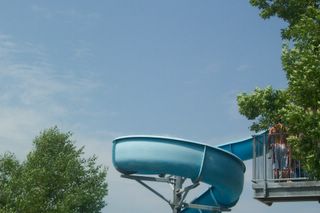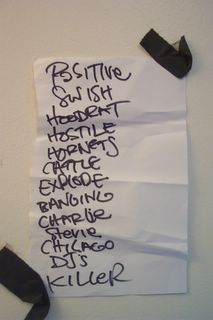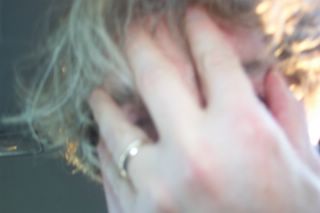Thursday, June 30, 2005
Wednesday, June 29, 2005
Pools of Prosperity
 Shuffling into the Prairie Village pool complex for the first time on Memorial Day weekend was like entering Valhalla.
Shuffling into the Prairie Village pool complex for the first time on Memorial Day weekend was like entering Valhalla.Since when did public pools become oceans of opulence? No wonder my property taxes are so high.
There are many ways to get wet. Laps are swum in an Olympic-sized pool. Nearby, floating females raft in the adult-only pool. Kids wallow in an enormous lagoon with a fifteen-foot shower in one corner. The diapered set and their keepers- babysitters and nannies may outnumber moms- have their own baby puddle. Across the complex, two water slides dump into a turbulent vortex, while spirited divers splash into their own pool.
Adjacent tennis courts and skateboard park complete the scene. Boy, it's really nice. And the water's always just right. I ventured to the Leawood pool (water slide, pictured) for the first time today and discovered that it's just as elaborate.
I suppose years of living in P.V., KS, where even the grocery stores are pristine, have acclimated me to its absurd abundance. But it took these public pleasure palaces to remind me that I'm truly living at the deep end.
Now check out this cannonball...
Monday, June 27, 2005
Bird's Nest On the Ground
 As a jazz fan in Kansas City, I’m always pleased when attention is drawn to the legendary Charlie "Bird" Parker. New research by local music historian and disc jockey Chuck Haddix revealed that Parker resided at two tony midtown addresses in his youth. Previously, Parker was thought to have lived at only the outskirts of town. The Kansas City Star ran a nice front page feature based on this news on Sunday, June 26.
As a jazz fan in Kansas City, I’m always pleased when attention is drawn to the legendary Charlie "Bird" Parker. New research by local music historian and disc jockey Chuck Haddix revealed that Parker resided at two tony midtown addresses in his youth. Previously, Parker was thought to have lived at only the outskirts of town. The Kansas City Star ran a nice front page feature based on this news on Sunday, June 26.It provides excellent insight into the man's early years, and I’ll be hard pressed to resist bringing a boom box to the front stoop of these structures just to hear how Parker’s Mood sounds there. The story quoted local luminaries; some discussed submitting the sites to the National Register of Historic Places list. But how many people in Kansas City, aside from Haddix and I, actually care about Parker and his legacy?
Local sales of the saxophonist’s recordings tell a far different story than the one happy version recited by Kansas City's cultural and political elite.
Soundscan, the music industry’s sales reporting tool, has been recording sales of prerecorded music since 1991. A handful of outlets, mostly mom-and-pop operations, aren’t registered. Locally, shops including Music Exchange and Recycled Sounds don’t report to Soundscan. To compensate, other retailers are overweighted. For example, the Borders store at 91st and Metcalf reports two sales for each jazz and world title it sells. And online retailers like Amazon report sales within its customers’ regions, so an order placed to Amazon from Overland Park is recorded as a Kansas City-area sale. Furthermore, Soundscan counts all legal digital download purchases.
A bit of Bird’s history and recorded legacy is in order before the numbers are crunched. Like many musicians, Parker led a complicated, disorderly life that began in Kansas City, KS, in 1920. It ended a mere 35 years later. His first recordings were made in 1940 with Jay McShann, but his reputation as a revolutionary innovator didn’t take flight until the end of World War II. As his cult following increased, maniacal fans took to recording every note Parker played. In the studio, he worked for Savoy, Dial, and finally, the Verve label.
All of this material has been repeatedly repackaged and reissued. Soundscan lists 328 individual Parker titles. Of these, 79 have zero sales. Assuming that those 79 titles were never issued, that leaves 249 actual titles. The total sales for those releases since 1991 is 1,496,695. The average sales per title is 6,011. The average cumulative sales per year is 106,906.
While those numbers aren’t world-beaters, I find them entirely palatable. Jazz is a difficult music, and Parker was anything but smooth. The bebop revolution, led by Parker, remains controversial to this day. Along with the advent of rock’n’roll, the gauntlet laid down by bebop permanently displaced jazz music from the forefront of the American popular culture.
By comparison, today’s most acclaimed serious jazz saxophonist, Joe Lovano, averages sales of 15,000 units each of his Blue Note recordings. Keep in mind, too, that sales of Parker in Europe and Japan are likely at least a significant portion of what they are domestically. Of course, it’s all relative. We live in a world in which country-pop star Toby Keith sold 125,000 units last week.
It’s no surprise that the three best selling Parker titles are on Verve. First, Parker made his most commercial recordings for the label, including the controversial "with strings" sessions. Secondly, Verve enjoys major label distribution, which helps force product into retail. Jazz ‘Round Midnight, the top seller, was issued in 1991, and has sold 126, 475 units, including 49 last week. Ken Burns Jazz, compiled in conjunction with the PBS series, was issued in 2000, has sold 90,039, including 107 units last week. Bird: Original Recordings, issued in 1988, has sold 104,753, including 26 last week. The title I recommend most highly, a budget-priced 5-CD set called Studio Chronicle: 1940-1948, has sold 3,010 units since its release in 2001, including 17 last week.
But what about sales in Kansas City? Jazz ‘Round Midnight has sold a total of 939 units in Kansas City, including 2 last week. Ken Burns Jazz has sold a total of 721 in here, including 1 last week. Bird: Original Recordings, has sold 851 in Kansas City, with no sales last week. The Studio Chronicle box has sold a woeful 10 units in Kansas City, including 1 last week.
Kansas City is Soundscan’s 29th largest market. Correspondingly, even dismissing favorable regional hometown bias, Parker should account for every 3 in a 100 Parker sales. Does it? Not even close. Kansas City represents significantly less than 1% of total sales in the United States.
Why? That’s a loaded question. Are we a bunch of backwards rubes? Are we angry at Parker’s stormy relationship with our town? Or maybe, just maybe, Kansas City is at the vanguard of a very conscious and deliberate critical rejection of bebop and it’s significance in the 21st century.
Or maybe not.
It’s really not so hard to understand why Bird doesn’t fly here. There’s little traction among retail, radio, print, and the live scene.
Kansas City retail is a non-factor. Borders and Barnes & Noble, both national chains, have respectable jazz sections. And while I love the guys and Music Exchange, they’d sooner warehouse collectable vinyl than sell you a shrink-wrapped Parker CD. Conversely, nearby St. Louis boasts Webster Records, a jazz specialist store. And several independent stores there, including Vintage Vinyl and Euclid, employ a staff that's eager to talk jazz.
Needless to say, Parker isn't played on commercial radio. But you’ll hear discerning non-commercial regional disc jockeys play Bird, at Lawrence's KANU. KCUR, aside from two hours on Sunday devoted to swing, has no jazz programming. KKFI plays plenty of jazz each weekday, but I’m not convinced anyone's listening.
A bright spot is the Kansas City Jazz Ambassadors. These jazz advocates, although they're typically moldy figs, have their hearts in the right place and they issue a fine bi-monthly publication. The Star dedicates plenty of space to jazz music, but it sometimes seems like a sort of token musical affirmation action policy. Several area clubs feature live jazz nightly, but noone’s going to call it a happening scene. There’s a world of talent in town, especially in the traditionalist camp. But sometimes it seems that there are more musicians than fans.
And yes, I’m aware of the institutions at 18th and Vine, and aside from some fine live music on stage, I’m not impressed with the cavalier sense of obligation there.
So, what’s to be done? Change, if it’s even possible, must come organically through genuine enthusiasm for the music. Bird tastes really bad when force-fed. Clearly, the Ken Burns it’s-good-for-you force-feeding can sell tens of thousands of CDs (if less than a thousand in Kansas City), but getting it stick is another matter entirely. The PBS series ran in 2000, and the fine film bio starring Forest Whitaker's came out in 1988.
Here's my ideal scenario. A young, charismatic group of local musicians lifts the Parker banner. Perhaps they'll call themselves Confirmation. They breathe new life into the Parker songbook, offending purists with their punk attitude even while they play the music straight. The controversial band becomes a popular staple at rock clubs and at regional jazz festivals. Area hipsters start whistling Relaxin' At Camarillo. High school skateboarders take to wearing homemade Ornithology shirts. A new era of Parker chic emerges from Kansas City.
Until that day, look for me in midtown, annoying confused landlords with my boom box.
Sunday, June 26, 2005
Bagpipes and Bolly
 Two unrelated events allowed for a cosmopolitan juxtaposition of Scottish bagpipes and Indian cricket at Swope Park on Sunday afternoon, June 26. Also spotted at the sprawling park were adult soccer teams that appeared capable of challenging The Wizards. Their intricate play was enhanced by salsa booming from nearby car stereos.
Two unrelated events allowed for a cosmopolitan juxtaposition of Scottish bagpipes and Indian cricket at Swope Park on Sunday afternoon, June 26. Also spotted at the sprawling park were adult soccer teams that appeared capable of challenging The Wizards. Their intricate play was enhanced by salsa booming from nearby car stereos.
Saturday, June 25, 2005
Chick Willis
 Low key and thoroughly unpretentious, the Kansas City Kansas Street Blues Festival is the antithesis of most summer music festivals.
Low key and thoroughly unpretentious, the Kansas City Kansas Street Blues Festival is the antithesis of most summer music festivals.As it’s on a primarily residential street, there’s no gate. And the best seats are the front porches of the houses. Most people BYOB, but thirsty patrons can walk into the venerable Club Paradox to get a cold one and collect some shade. A few ambitious neighbors hawk barbecue or jerk chicken. It’s an all-American street party.
On Saturday, June 25, local favorite blues man Chick Willis (pictured) gave the people want they wanted. "Ain’t nothing but a party," the "Stoop Down Man" repeatedly chuckled between songs. Wandering the crowd as he played extended guitar solos, his brand of contemporary blues went down easy as the sun began to wane.
Scheduled to follow Willis was a set by local favorite Ida McBeth. Friday's headliner was the ultra-funky Bobby Rush, while Sunday was to feature over a dozen gospel acts.
Much Ado About Nothing
 If only the actual production of Much Ado About Nothing, this year’s offering at Kansas City’s Shakespeare In the Park, was as good as the puppet show that precedes it.
If only the actual production of Much Ado About Nothing, this year’s offering at Kansas City’s Shakespeare In the Park, was as good as the puppet show that precedes it.The Paul Mesner Puppets is one of Kansas City’s treasures. And in ten minutes, his capsule introduction of the play is hysterical and insightful (pictured). The same can’t be said for the performance on the live stage nearby on Friday, June 24. Technical glitches, flat readings, inconsistent tone, a drab set, and the use of hideously unimaginative music tether the production to mediocrity.
Still, few things in life can compare to Shakespeare performed outdoors. Emergency helicopters buzzing around St. Luke’s Hospital, martins swooping at dusk, lightning bugs enchanting tired children, the glorious sound of wine bottles opening, and sublime people-watching more than compensate for any deficiencies on stage.
To be fair, it’s not all bad. Scott Cordes, my favorite regional actor, transforms the role of Dogberry into a ludicrous Three Stooges-ish buffoon. And Cinnamon Schultz, playing Hero, is always reliable as a comic. The director should encourage the rest of the cast to follow their playful leads. This isn't Hamlet, after all.
For superior drama, catch the puppets before the show. Then expand your focus to the bountiful to be found on- but mostly off- the main stage at Southmoreland Park.
The Hold Steady
 It was after one on Monday morning and a pitcher of beer was being sloshed around the postcard-sized stage. Everyone’s mug- band and fans alike- was filled in a communal salute to a night of rock’n’roll debauchery.
It was after one on Monday morning and a pitcher of beer was being sloshed around the postcard-sized stage. Everyone’s mug- band and fans alike- was filled in a communal salute to a night of rock’n’roll debauchery.I recall elbowing a hippie dancer away from the stage so I could sing along directly into front man Craig Finn’s face. There was vodka and Red Bull- only my wallet knows how many.
It was the kind of night in which I didn’t even care that I insulted a good friend’s girlfriend, or that the workweek began in a few hours. Nothing mattered except for the fact that I was about to receive a purification, an affirmation of my love of popular music. The Hold Steady were in town. And I had a ride home.
Less than 50 people were around on June 20 at The Jackpot Saloon in Lawrence, KS, when Finn’s declamatory barking began. A dizzying hour later, all were drained as if our collective sweat, tears, along with a little sacrificial blood, lay the floor, pooled among the spilled beer.
Exhausted, my pal Shannon cried, "They almost killed me."
Existing fans will know from the set list (pictured, snatched by a rabid fan boy) that this event was a raging tent revival. Finn’s confrontational between-song banter targeted Boz Skaggs and The New York Yankees, which compelled me to smack the offending cap off a nearby patron.
The band- organ, bass, guitar and drums- careened through the set like ace studio musicians held hostage at gunpoint and forced to drink Jagermeister as part of their sadistic torture regimen.
With the release of Darkness On the Edge of Town in 1978, I became an acolyte of Bruce Springsteen. Twenty-seven years later, almost none of my old peers still hit the clubs and record stores. So when I proselytize to kids about this furious new band that’s based on the epic grandeur of Born To Run, I get blank stares or often, open scorn, in return.
Critics have been quick to comment on this connection, along with The Hold Steady’s nods to AC/DC and Cheap Trick. I mostly hear a brilliant merging of Husker Du’s noisy melodic sensibility with Bruce Springsteen’s equally passionate conviction in street poet word-play.
At this late date, The Hold Steady confirm that my faith in the redeeming power of this music isn’t futile. It’s sustained, and more significantly, resurrected, even if only a few of my little hood rat friends are there to witness the miracle.
Friday, June 24, 2005
Warped Tour

The oppressive heat overwhelmed audience and performers alike at the Warped Tour date in Kansas City on June 23, 2005. The only consistent shade I could find was in the Cutz tent, which featured compelling artists including Eternia (pictured).
Her original material is funny and smart, but it was Eternia's cover of Jeru The Damaja's The Bichez that stood out. With my mind melting, I failed in an audience participation segment by only meekly mumbling- a split-second late- the chorus when Eternia shoved her mic in my face. And it wasn't just me; Eternia had to sit down for one of her numbers.
Note the dude appreciating Eternia in the photo. Unlike him, I didn't go shirtless, and consequently my farmer's tan is smoking.
In the five hours I stuck it out, I saw The All-American Rejects (a younger, blues-free Aerosmith), Armor For Sleep (excellent emo), The Feds (G'n'R-style rock), The Matches (ok, I guess), MXPX (poor, Christian man's Social D), The Offspring (competent), Plain White T's (adequate), The Raging Hormones (high school ska project's last gig), The Starting Line (I don't get it), Stutterfly (generic rock), The Transplants (disappointing supergroup), Underoath (first-rate Christian screamo), and Valient Thorr (belligerent Nugent-style rock wildly out of place).




